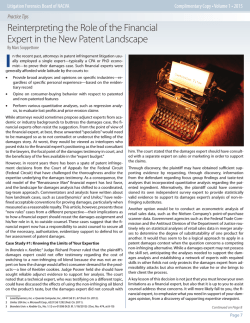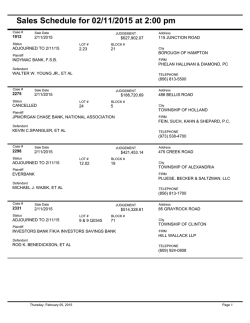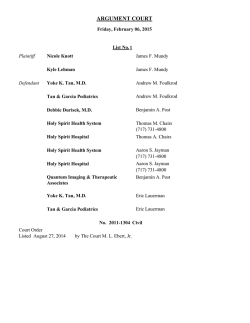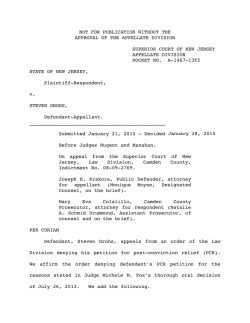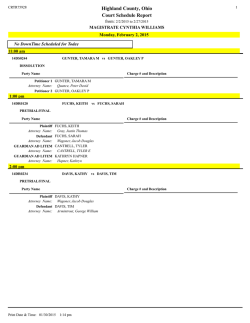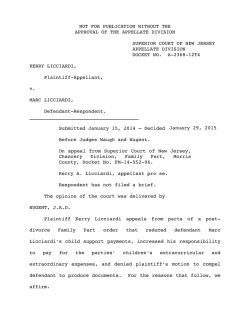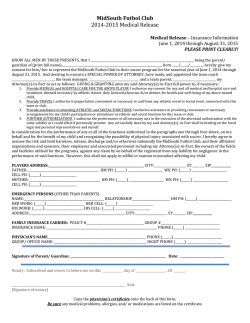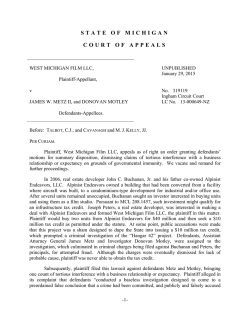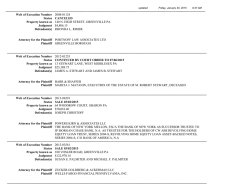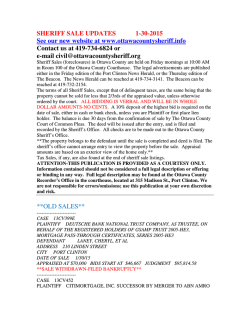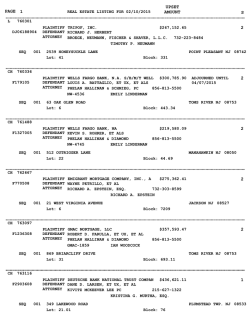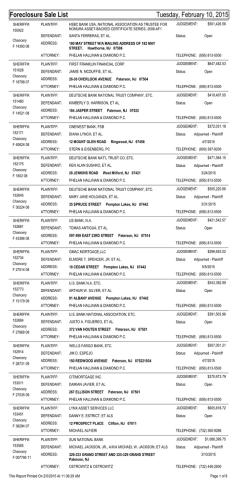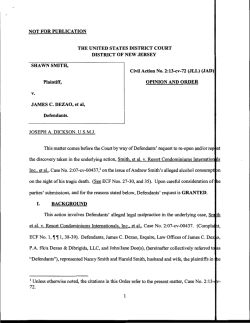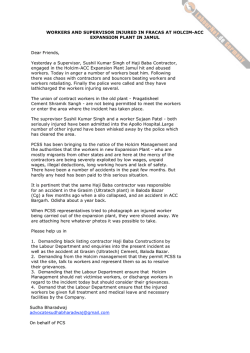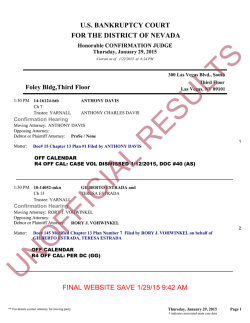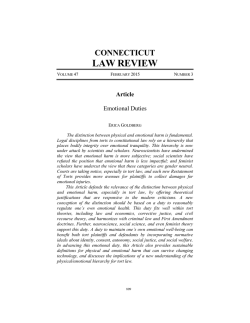
Guide To Personal Injury
Personal Injury Personal injury accidents happen all the time. From sidewalk cracks to car accidents, when people are injured, the question of who is legally and financially responsible is inevitably asked. Table of Contents Because circumstances vary widely, and individual state laws are the primary governing factor, this Guidebook is a high-level look at what personal injury cases are and the basic concepts you may want to know in case you are considering filing a claim. Glossary 4 What is a Personal Injury Case? 6 What Would My Case be Worth? 8 How Do You Prove a Claim? 10 What Does Insurance Cover? 12 How Do I File a Claim for Injuries? 14 When Do I Need an Attorney? 16 What If My Case Goes to Trial? 17 Collecting Judgment 19 Let Us Help You 20 Preparing to Meet Your Attorney 23 Resources for More Information 26 If you have additional questions, ARAG® can help. If you have ideas on how to improve this Guidebook, please share them with us at [email protected]. If you’re not an ARAG member, please feel free to review this information and contact us to learn how ARAG can offer you affordable legal resources and support. Sincerely, ARAG Customer Care Team Checklists27 2 ARAGLegalCenter.com • 800-247-4184 3 Glossary Comparative negligence. A rule of law that applies to personal injury cases in most states. Comparative negligence states that when an accident occurs, the fault/negligence of each party involved is based upon their respective contributions to the accident. Resulting claims are paid according to the degree of responsibility each party contributed. Contributory negligence. A few states follow the rule of law stating that if a person is injured and his or her negligence contributed, even if in part, to the accident, the injured party would not be entitled to have any expenses of the accident reimbursed by the party who supposedly caused the accident. Statute of limitations. A type of federal or state law that restricts the time within which legal proceedings may be brought. The statute of limitations is a defense that is ordinarily asserted by the defendant to defeat an action brought against him after the appropriate time has elapsed. Strict liability. Absolute legal responsibility for an injury that can be imposed on the wrongdoer without proof of carelessness or fault. Strict liability, sometimes called absolute liability, is the legal responsibility for damages, or injury, even if the person found strictly liable was not at fault or negligent. General damages. Monetary recovery in a lawsuit for injuries suffered (such as pain, suffering, inability to perform certain functions) or breach of contract for which no exact dollar value can be calculated. Negligence. A legal term for any careless behavior that causes or contributes to an accident. For most types of accidents, a person must be found negligent in order to be held legally responsible for another person’s injuries. If a person behaves negligently and that behavior causes you harm, you can most likely recover compensation for your injuries. Punitive damages. Monetary recovery that may be paid in addition to actual damages, which compensate a plaintiff for the losses suffered due to the harm caused by the defendant. The purposes of punitive damages are to punish the defendant for outrageous misconduct and to deter the defendant and others from similar misbehavior in the future. Special damages. Damages that compensate the plaintiff for quantifiable monetary losses such as medical bills and the cost to repair damaged property and lost earnings. Distinguished from general damages, for which there is no exact dollar value to the plaintiff’s losses. 4 ARAGLegalCenter.com • 800-247-4184 5 What is a Personal Injury Case? A personal injury case is when a person suffers injury due to another person’s actions, or failure to act when the person should. The basic issues that make up a case revolve around who was liable, or legally responsible, for the incident causing harm and what amount needs to be paid to the person who was injured. Common types of personal injury cases. Personal injury cases include: • Road traffic accidents such as when a vehicle collides with another vehicle, pedestrian, animal, road debris, or other obstruction, such as a tree or utility pole. • Tripping accidents whether inside or outside a building due to either unsafe conditions or misuse of the property. • Assault and battery claims where assault is defined as the threat of an imminent, harmful act and battery is the actual intentional harmful contact with another. • Product defect accidents due to either manufacturer mistake, dangerous product design or a failure to provide adequate warning. • Medical negligence where a patient receives improper, unskilled or negligent treatment by a physician, dentist, nurse, pharmacist or other healthcare professional. Invasion of privacy, slander and libel are kinds of personal injuries but are outside the scope of this Guidebook. Personal injuries sustained by a worker in a work-related setting (including work-related accidents or illnesses, or industrial diseases) are typically handled though a state or federal statutory and administrative process known as worker’s compensation. Worker’s compensation cases are also beyond the scope of this Guidebook. 6 ARAGLegalCenter.com • 800-247-4184 7 What Would My Case Be Worth? The amount paid in a personal injury case (known as damages) is determined by the amount of expenses incurred, the loss of potential income the accident may have caused, as well as an amount for emotional stress or suffering. In some cases, an additional amount may be paid if a court decides the defendant’s actions should be punished. In a personal injury case, the plaintiff (the injured person) may receive damages from the defendant (if the person was found to be legally responsible for the injuries). Damages may be negotiated among these persons, their insurance companies, and/or attorneys or damages may be determined by a judge after a court trial. Compensatory damages reflect an amount paid to replace, or compensate, what the injured party lost due to the accident. This includes payment for property damage and medical bills, and may also include an amount for pain and suffering or an amount for other life altering loss, such as inability to enjoy hobbies, relationships or other activities due to accident-related injuries. Compensatory damages include the types of damages embraced within the concepts of special and general damages under the law of the state where the injury occurred. Punitive damages are an amount paid to punish the defendant, and are awarded when the defendant’s behavior is significantly outside the range of what any cautious person may have done. The intent is to clarify that the defendant was acting beyond reasonable behavior and to defer future behavior. The ability to claim and recover punitive damages, as well as the process for claiming them, may be limited by state law or court rule. 8 ARAGLegalCenter.com • 800-247-4184 9 How Do You Prove a Claim? While comparative negligence may reduce the amount of damages a person receives, contributory negligence principles eliminate any award for damages if the plaintiff is found to be even partially responsible. Defenses are the arguments a defendant may use to show that the plaintiff may be completely or partially responsible for the accident or that the plaintiff acted in other ways that make him or her ineligible for the amount of damages requested. Besides arguing that he was not at fault (and thus denying all liability for the plaintiff’s injuries) the defendant may argue that he has specific defenses to liability. Common defenses to a negligence claim include the following: Assumption of risk means that a person has given up some right to hold another person responsible for damages that could be caused by a product or activity because the product or activity was known to be risky. For instance, if a person chooses to ride a roller coaster, he or she assumes the risk of potential neck strain from the ride. Plaintiff’s role in the accident . One of the first arguments from the defendant may be that the plaintiff is at fault, or partially at fault, for causing the accident or injury. The degree to which the plaintiff is at fault can affect whether any damages are paid or the amount of damages paid. These arguments generally fall into the defenses of comparative negligence, contributory negligence and assumption of risk. Comparative negligence means that damages will be calculated under a formula that looks at each party’s degree of fault for the accident. Most states follow comparative negligence principles, but differ whether they use a pure comparative negligence system or a modified comparative negligence system. Plaintiff “fails to mitigate damages.” Even if a person is injured due to another person’s actions, he or she must still take reasonable actions to minimize the injury or amount of suffering. For instance, if a person were in a car accident, but didn’t seek medical care within a reasonable amount of time, the additional damage done by waiting would not be the defendant’s responsibility. Plaintiff “fails to timely act.” The law of the state where the lawsuit is filed will state time limits within which the lawsuit must be filed depending on the nature of the claim. The state’s laws may also require that the plaintiff give certain notices (e.g., to a governmental defendant) or secure certain expert opinions (e.g., an independent medical expert in a medical malpractice claim) within certain time limits as a prerequisite to filing any lawsuit. • Pure comparative negligence means a plaintiff can recover damages as long as they are not completely at fault. • Modified comparative negligence means a plaintiff can only recover damages depending on their percentage of fault. Some states follow a 50% rule wherein the plaintiff can only recover if his fault is 49% or less. Other states follow a 51% rule wherein the plaintiff can only recover if his fault does not reach 51%. 10 ARAGLegalCenter.com • 800-247-4184 11 What Does Insurance Cover? No-fault laws usually have limits that, if exceeded, open the possibility of a suit. Limits can be based on a specific dollar amount, clearly defined injuries and/or a death resulting from an accident. Auto. Most auto liability insurance policies contain three major parts to cover bodily injury, property damage and damage caused by an uninsured or Homeowners. Coverage generally covers injuries that happen on your property, such as someone slipping on a patch of ice on your sidewalk or falling on a broken step on your porch. The insurer’s coverage limit is what the homeowner’s policy specifies; damages in excess of that limit would have to be recovered from the homeowner personally. underinsured driver. • Bodily injury liability insurance covers claims made against an insured driver (or the owner of the auto the driver was using) who caused physical injury to other people. Specifically, the insurance covers claims for medical expenses, lost wages, and pain and suffering. • Property damage liability insurance covers claims against an insured driver (or the owner of the auto the driver was using) who caused property damage such as damage to another vehicle, fence, or tree caused by Umbrella. This personal liability coverage extends the basic coverage provided in different types of liability coverage, including home, auto, boat and tenant policies. a collision. • Uninsured motorist coverage protects an insured driver who is injured by a hitand-run driver or a driver who does not have auto liability insurance • Underinsured motorist coverage protects an insured driver who is injured by another driver whose coverage is less than the damages sustained. In states with no-fault laws, the fault of the parties is not determined; rather, each party files a claim with his or her insurance company. No-fault does not eliminate the risk of a lawsuit; however, no-fault laws place restrictions on when a suit can be brought forward. Coverages typically available in a no-fault system are Personal Injury Protection (PIP) and Residual Bodily Injury Liability Coverage. • Personal Injury Protection (PIP) coverage pays the driver, any passengers, or their survivors an amount per person. Benefits vary widely by state and typically include medical expenses, rehabilitation expenses, lost wages, funeral expenses and survivor’s loss benefits. • Residual Bodily Injury Liability Coverage protects anyone in the car if the driver is sued for causing injuries to others. 12 ARAGLegalCenter.com • 800-247-4184 13 How Do I File a Claim for Injuries? Independent legal advice (if not already represented) can be very helpful and is often essential in a personal injury claim. The following is an overview of how the claims submission and negotiation processes work. Many of the steps may be more effectively handled by your attorney. Start by identifying the person, party or entity you believe is responsible for the injury. Contact your insurance company as soon as possible. Contact the negligent party’s insurer, if known. Your insurance company may want to take over the case and if so provide them with as much information as you have. If your insurance company is not going to take the lead, gather facts that prove your claim and then send a demand letter to the negligent party’s insurance company, if known, or to the negligent party to forward on to their insurance company. In this letter, you need to demonstrate: • why the insured person is legally responsible for your injuries • what your injuries were and are • what kind of medical treatment you’ve had and how much it cost • what your income loss was • what other damages you suffered • the amount of money you will accept to settle your claim If you have no-fault automobile insurance, you’ll also need to state why you need to make a claim against the insured person. Keep in mind that accepting a cash payment may compromise or end any other claims you may have. It is often in your best interest to consult an attorney before proceeding with negotiations. 14 After the insurance company reviews your demand letter and supporting information, you will likely negotiate the claim with an insurance claims adjuster. If you insurance company is handling the claim, they will negotiate with the other insurance carrier. How the negotiation process generally works. Generally, in the first call, you and the adjuster will discuss the details of the claim. The adjuster may offer to settle for an amount lower than you have requested. To keep the negotiations open, it may be best to counter with an amount higher than the adjuster’s offer but lower than your original figure. Typically an amount between those starting points will be agreed on within a few phone calls. Keep in mind that the opposing insurer will almost always record the call and will seek to elicit statements from you that defeat or limit the claim. This is yet another reason why it is in a plaintiff’s best interest to seek, or at minimum consult, independent legal advice. What the Insurance Company Will Base Payment on. While the final payment depends on negotiations with the injured person; the range of compensation for an injury is determined by a range that allows for: • medical care • lost income • temporary and permanent pain • physical discomfort and disability • loss of family, social, and educational experiences Time to File. Depending on where you live, the type of injury was sustained, and who or what caused the injury, there are time limits called statute of limitations to filing a personal injury claim. These time limits are set in a state’s laws and vary greatly; it is essential to promptly find out what limits apply and what action is necessary to meet the limits. ARAGLegalCenter.com • 800-247-4184 15 When Do I Need an Attorney? What if My Case Goes to Trial? In certain situations, you may deal directly with the person at fault and his or her insurance company. It’s wise to talk with an attorney if your case is particularly complex, your injuries are severe enough to have a great impact on your compensation or if the insurance company does not settle. The simple fact is that anyone with any personal injuries should consider consulting with an attorney before dealing with the other side, the other side’s attorney, or the other side’s insurer. This helps protect the person with injuries since the extent of injuries may not be fully known at the time that contacts are made and settlements are always made with binding releases. While some personal injury cases may be handled without filing a lawsuit or going to court, if the case is complex or a settlement cannot be reached, a suit may be filed and a judge or jury will consider the evidence to decide who is responsible for the injuries. Personal injury litigation is both lengthy and complicated and should not be entered into without representation by an attorney. If I hire an attorney, how will he or she be paid? Many attorneys take on a personal injury case on a contingent basis or “no win, no fee” agreement. If the client does not win the case, he or she is not responsible for paying the attorney’s fees. If the case is won, however, the attorney is paid a fee based on the amount of damages awarded. In a contingent fee arrangement, the attorney generally agrees to accept a fixed percentage (often one-third) of the amount finally paid. While you only pay the attorney if the case is won, you will still need to pay for expenses incurred in pursuing the lawsuit such as court filing fees, the costs related to deposing witnesses and similar charges. Generally, an attorney for the injured person (the plaintiff) may bring the case to court to have the opportunity to argue the case and win or settle. Or an attorney for the person accused of injuries (the defendant) may take the case to court to argue the evidence and prove that his or her client should not be found at fault. The six phases of a personal injury trial include: Choosing a Jury. During jury selection, the judge (and generally the attorneys of the plaintiff and defendant) interviews potential jurors to find out their experiences, biases or predispositions about the case. Opening Statements. After the jury is selected, the plaintiff’s attorney and the defendant’s attorney make general statements that introduce the jury to what each side will try to prove in the trial. The plaintiff’s attorney will present facts and the defendant’s alleged role in causing the plaintiff’s damages. The defendant’s attorney also presents facts and sets the stage for refuting the plaintiff’s evidence. Witness Testimony and Cross-Examination. This is the stage where each side is allowed to present evidence and witnesses and then have an opportunity to refute what the other side has said. Closing Arguments. Similar to opening statements, each attorney summarizes what they have shown and why the evidence requires the jury to find for that side. 16 ARAGLegalCenter.com • 800-247-4184 17 Jury Instruction. Next the judge gives the jury the set of legal standards it will use to decide whether the defendant should be held accountable for the plaintiff’s harm. Jury Deliberation and Verdict. The jury then considers the case and attempts to agree on the defendant’s liability, and if the defendant is found to be accountable, how much to award the plaintiff. Once a decision is reached, the jury foreperson tells the judge and the judge announces the verdict in court. Collecting Judgment In many cases, individuals (or more likely, their insurers) usually pay judgments they are found to owe. If the individual does not have the means to pay, or simply refuses to pay for other reasons, collecting that judgment can be difficult. In most states, an attorney or collection agency will need to be hired to help with collection efforts. In most states, a plaintiff can uncover a debtor’s income and assets through post-judgment discovery which includes depositions, interrogatories and request for production of documents. If a judgment is assessed against the defendant, the plaintiff may be able to file to garnish a paycheck or bank account; however, there are statutory limits on whether a judgment debtor’s wages can be garnished, or if permitted, the amount that can be garnished. State law sets the time limit for collecting a judgment; in some states it is as low as seven years and in others as long as 20 years. After that time, a state’s laws will dictate whether there is a time limit on enforcing a judgment, whether a judgment’s life can be extended and if so for how long. If a debtor files bankruptcy, the person holding a judgment will have to file a claim in the bankruptcy proceeding and halt enforcement efforts until the bankruptcy court issues orders in the case. If the debtor or his or her property is in another state, the plaintiff will need to record the judgment as a foreign judgment in that state. 18 ARAGLegalCenter.com • 800-247-4184 19 Let us help you If you need additional help or guidance, ARAG is here for you. Simply contact a Customer Care Specialist who can help you understand the benefits available to you. For more information: Visit the Education Center at: ARAGLegalCenter.com, call 1-800-247-4184 or email [email protected] 20 ARAGLegalCenter.com • 800-247-4184 21 Preparing to Meet Your Attorney If you decide to consult an attorney about your legal matters, we suggest you complete the following worksheet prior to your meeting. By preparing this information ahead of time, you have the opportunity to clearly think through your needs and the attorney will have the necessary information to provide you with the highest level of legal service. Start by thinking about your current situation, the communications you have received and any history you have about the legal matter. Summarize your legal needs in a few sentences. Use this as a starting point when you make your first phone call to an attorney. 22 ARAGLegalCenter.com • 800-247-4184 23 List the names, dates and pertinent details about your legal matter so you will be ready to discuss it with your attorney either over the phone or during an in-office visit. 24 List and attach any documents or background information you think will be helpful in the first meeting with an attorney. ARAGLegalCenter.com • 800-247-4184 25 Resources For More Information Checklist The following were used as resources in developing this guidebook and provide additional information. What to do if an accident occurs. If you are in an accident, consider taking the following steps: American Bar Association: http://www.americanbar.org/groups/public_education/resources/law_issues_ for_consumers/lawyerfees_contingent.html National Association of Insurance Commissioners: http://www.naic.org/documents/consumer_alert_understanding_auto.htm Check for any injuries. Seek medical attention, regardless of injuries. Call the proper authorities and inform them of the accident and of any injuries. Regardless of the circumstances, report the accident to the police. Collect evidence that points to who caused the accident as well as damage caused by the accident. If you’ve been in a car accident, record the name, address and phone number of the other driver. Always write down the make and license number of all vehicles involved and exchange insurance information with the other drivers. Collect the names, addresses and phone numbers of all passengers and witnesses. Take photos of the accident scene if possible. Do not admit fault. If you’ve been in a car accident, ask the investigating officer how to obtain a copy of the police report. Write down all expenses that resulted because of the accident, including medical bills, hospital visits, lost work or wages. Keep any supporting documentation. This publication is provided as educational material for members of ARAG legal plans. While every effort has been made to ensure the accuracy of this publication, it is not intended as legal advice as individual situations will differ and should be discussed with an expert and/or lawyer. If you have questions concerning coverage, please refer to your ARAG legal plan. We have provided links to web sites for information that may be of interest to you. These links and any opinions, products, services, or any other sites contained therein are not endorsed by ARAG. ARAG is not responsible for the legality or accuracy of the information contained therein, or for any costs incurred while using this site. 26 Notify your agent or insurance company immediately. If you are injured on government property, immediately notify the respective county, city, state or federal governmental entity. If you are injured on private property, such as a business property or residential property, notify the building manager or property owner. ARAGLegalCenter.com • 800-247-4184 27 ARAGLegalCenter.com 800-247-4184 © 2014 ARAG North America, Inc. 363212 (10.14)
© Copyright 2025
